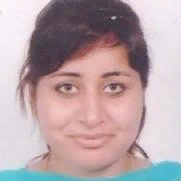
Surbhi Sharma
Work place: Department of Electronics and Communication Engineering National Institute of Technology, Kurukshetra, India
E-mail: s.surbhi1986@gmail.com
Website:
Research Interests: Theoretical Computer Science, Image Processing, Computer Architecture and Organization, Computer Vision, Computer systems and computational processes
Biography
Surbhi Sharma, received B.Tech. degree in Electronics and Communication from Kurukshetra University, India in 2004 and M.Tech degree in Electronics and Communication Engineering from MMU University, Mullana, Haryana, India in 2010. She worked as an Assistant Professor in Electronics and Communication Engineering at National Institute of Technology, Kurukshetra. Now, she is a Ph.D. research scholar at National Institute of Technology, Kurukshetra and her research interests are image processing, computer vision and machine learning.
Author Articles
Spliced Image Classification and Tampered Region Localization Using Local Directional Pattern
By Surbhi Sharma Umesh Ghanekar
DOI: https://doi.org/10.5815/ijigsp.2019.03.05, Pub. Date: 8 Mar. 2019
In this paper the authors have proposed a spliced image detection algorithm based on Local Directional Pattern (LDP). The output of many splicing detection techniques is either to classify spliced image from authentic images or to localize the spliced region. But the proposed algorithm has ability to classify and to localize the spliced region. First, the original image (RGB color space) is converted to Ycbcr color space. The histogram of LDP of chrominance component of suspect image is used in classification. Whereas for localization of spliced region, the chrominance component of input image is divide into overlapping blocks; then, the LDP of each block is calculated. The standard deviation of each block is used as clue to visualize the spliced region. The experimental results are calculated in terms of accuracy, specificity (true negative tare), sensitivity (true positive rate) and error rate and proves effectiveness of the proposed algorithm. The accuracy of the proposed algorithm is 98.55 %. The algorithm is also robust against post splicing image processing operation such as gaussian blur, additive white gaussian noise, JPEG compression and scaling however, previous techniques have not considered these experimental environment.
[...] Read more.Other Articles
Subscribe to receive issue release notifications and newsletters from MECS Press journals